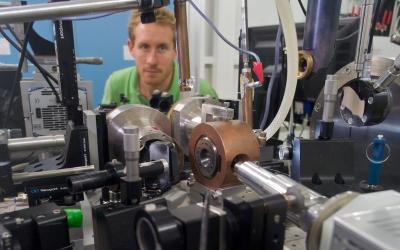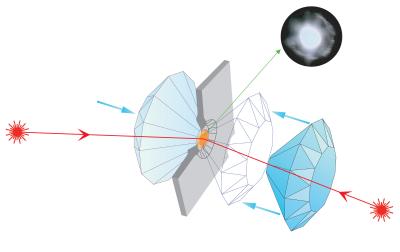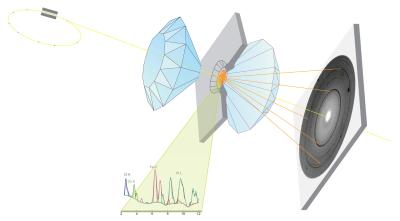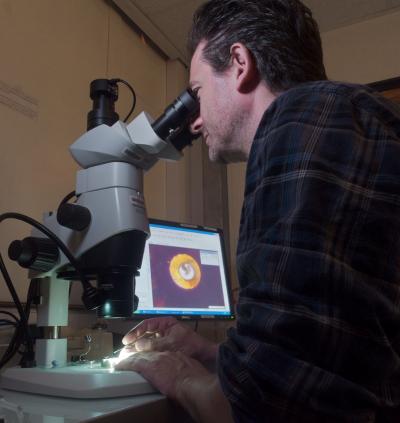- Home
- News
- General News
- X-rays illuminate...
X-rays illuminate the origin of volcanic hotspots
29-06-2012
Scientists have recreated the extreme conditions at the boundary between Earth’s core and its mantle, 2,900 km beneath the surface.
Share
Scientists have recreated the extreme conditions at the boundary between Earth’s core and its mantle, 2,900 km beneath the surface. Using the world’s most brilliant beam of X-rays, they probed speck-sized samples of rock at very high temperature and pressure to show for the first time that partially molten rock under these conditions is buoyant and should segregate towards the Earth’s surface. This observation is a strong evidence for the theory that volcanic hotspots like the Hawaiian Islands originate from mantle plumes generated at the Earth’s core-mantle boundary. The results are published in Nature dated 19 July 2012.
The group of scientists was led by Denis Andrault from the Laboratoire Magmas et Volcans of University Blaise Pascal in Clermont, and included scientists from the CNRS in Clermont and the European Synchrotron Radiation Facility (ESRF) in Grenoble, France.
 |
|
The experimental set-up of the experiment at ESRF beamline ID27 where the diffraction maps were recorded. The diamond anvil cell is inside the brass cylinder in the centre. Credit ESRF/Blascha Faust. |
Most volcanoes are situated where continental plates are pushed or pulled against each other. Here, the continental crust is weakened, and the magma can break through to the surface. The Pacific “Ring of Fire”, for example, exhibits such plate movements, resulting in powerful Earthquakes and numerous active volcanoes.
Volcanic hotspots are of a completely different nature because most of them are far away from plate boundaries. The Hawaiian Islands, for example, are a chain of volcanoes thought to have their origin in a mysterious hot spot beneath the Pacific ocean floor. Every island in the chain starts as an active volcano fed by the hot spot that eventually rises above the ocean surface. As plate tectonics move the volcano away from the hotspot, it becomes extinct. The hot spot will in the meantime create another volcano: the next island in the chain. The Hawaiian Islands are one of many examples of this process, like the Canary Islands, La Réunion or the Azores.
The nature of the hot-spot source and its location in the mantle have remained elusive to the present day. One explanation is narrow streams of magma conveyed to the Earth's surface from the boundary between the Earth’s core of liquid iron and the solid mantle of silicate rock. Whether the lowermost mantle expels such streams of magma called mantle plumes is one of today’s major controversies among geologists.
What material can be stored at the core-mantle boundary and become sufficiently light to rise through 2900 km of thick solid mantle? This was the question Denis Andrault and his colleagues addressed when they set out to recreate in a laboratory the conditions found at the core-mantle boundary. They compressed tiny pieces of rock, the size of a speck of dust and ten times thinner than a human hair, between the tips of two conical diamonds to a pressure of more than one million bar. A laser beam then heated these samples to temperatures between 3000 and 4000 degrees Celsius, which scientists believe is representative of the 200km-thick core-mantle boundary. The samples are extremely small compared to the natural processes occurring in the Earth. However, the melting processes are very well reproduced experimentally. Therefore, the observations can be confidently transferred from micron scale in the experiments to kilometre scale in the deep mantle.
Beams of X-rays at the ESRF, focused to a diameter of one 1000th of a millimetre, were used to map these samples and identify where the solid rock had melted. “Obviously, these tiny samples produce weak interaction signals, and this is why it is important to have the most brilliant X-ray beams for this type of experiments, says Mohammed Mezouar, the scientist responsible for the high-pressure beamline ID27 at the ESRF.
Once regions with molten rock had been identified, another X-ray technique was used at the ESRF to compare the chemical compositions of previously molten and solid parts. “It is the iron content which is decisive for the density of molten rock at the core-mantle boundary. Its accurate knowledge allowed us to determine that molten rock under these conditions is actually lighter than solid,” says Denis Andrault.
Gravity makes the light liquid rock from a hotspot move slowly upwards like a bubble in water until it reaches the surface where the magma plume will form a volcano. The hotspots of liquid occur in the relatively thin boundary region between the solid lower mantle and the liquid outer core of the Earth where the temperature rises over a distance of just 200 kilometres from 3000 to 4000 degrees. This steep rise is caused by the vicinity of the much hotter core and induces a partial melting of the rocks.
The results of the experiment are also of great significance for the understanding of the early history of the Earth, as they provide an explanation why many chemical elements playing a key role in our daily life gradually accumulated from the Earth’s inside to its thin crust, close to the surface.
“We know less about the Earth’s mantle than about the surface of Mars. It is impossible to drill a hole of even 100 kilometres into the Earth, so we have to recreate it in the laboratory. This is important knowledge, because active hot spot volcanoes like those in Iceland can be dangerous and disruptive for the daily lives of people far away”, concludes Denis Andrault.
Reference:
Denis Andrault, Sylvain Petitgirard, Giacomo Lo Nigro, Jean-Luc Devidal, Giulia Veronesi, Gaston Garbarino and Mohamed Mezouar: Solid-liquid iron partitioning in the Earth's deep mantle, Nature 487, 354–357 (2012).
Top image: Illustration of mantle plumes from the core-mantle boundary region reaching the Earth's crust. Due to the lateral displacement of the tectonic plates at the surface, the mantle plumes can create a series of aligned hot spot volcanoes.






